Elevated Accessible Routes
An elevated accessible route is the path used for connecting elevated play components. Elevated accessible routes must connect the entry and exit points of at least 50 percent of the elevated play components provided in the play area. Two common methods for providing access to elevated play components are ramps and transfer systems. Ramps are the preferred method since not all children who use wheelchairs or other mobility devices may be able to use - or may choose not to use - transfer systems.
A typical elevated accessible route might include the following:
-
36-inch (915 mm) clear width
-
32-inch (815 mm) narrowed width permitted for 24-inch (610 mm) length to accommodate features in the composite structure
-
12-inch (305 mm) rise maximum per ramp run
-
Top of handrail gripping surfaces shall be 20 inches (510 mm) minimum to 28 inches (710 mm) maximum above the ramp surface
When Ramps Are Required
Ramps are required on composite structures with 20 or more elevated play components and must connect to at least 25 percent of the elevated play components. Ramps allow individuals who use wheelchairs and mobility devices to access elevated play components in composite play structures without transferring.
This play area has more than 20 play components and provides ramp access to elevated play components. The ramp system, consisting of ramp runs and landings, must connect at least 25 percent of the elevated play components. The balance of the elevated play components required to be on an accessible route may be connected by the ramp system, or by a transfer system.
Rise of a ramp is the amount of vertical distance the inclined or slanted surface ascends or descends. A ramp run is a length of a continuous sloped surface that is ascending or descending. For example, to reach a 12-inch high deck or platform, a designer could use a 12-foot ramp with the maximum 1:12 slope, or a 14-foot ramp with a less-steep 1:14 slope.
Platform lifts, also known as "wheelchair lifts," may be considered for providing access to elevated play components when appropriate. Where applicable, platform lifts complying with ADAAG section 4.11 and applicable state and local codes are permitted as a part of an accessible route. Because lifts must be independently operable, owners and operators should carefully consider the appropriateness of their use in unsupervised settings.
Ramps
Ramps serve as a continuation of the accessible route from the ground allowing individuals who use mobility
devices to access elevated components. For each elevated ramp run:
-
12-inch (305 mm) maximum rise
-
1:12 maximum slope
-
36-inch (915 mm) minimum clear width
Maneuvering Space Where Ramps are Provided
At least one maneuvering space must be provided on the same level as the play component. The space must have a slope no steeper than 1:48 in all directions. The ADA and ABA Accessibility Guidelines address additional requirements for ramps and landings including edge protection, cross slope, surfaces, and outdoor conditions.
Landings
Landings are the level surfaces at the top and bottom of each ramp run.
-
Must be as wide as the ramp they connect to
-
A minimum length of 60 inches (1525 mm)
-
If ramps change direction, the minimum landing size must be 60 inches (1525 mm) wide to accommodate a turn
Handrails
Handrails are required on both sides of ramps connecting elevated play components. Handrails must comply with the following:
-
Clearance between handrail gripping surfaces and adjacent surfaces shall be 1 1/2 inches (38 mm) minimum.
-
Handrail gripping surfaces shall be continuous along their length and shall not be obstructed along their tops and sides. The bottoms of handrail gripping surfaces shall not be obstructed for more than 20 percent of their length. Where provided, horizontal projections shall occur 1 1/2 inches (38 mm) minimum below the bottom of the handrail gripping surface.
Handrails are required to comply with ADAAG 4.8.5. However, extensions on handrails in the play area are not required. This is to prevent children running into protruding rails in the play area.
When Transfer Systems Are Used
A transfer system provides access to elevated play components within a composite system by connecting different levels with transfer platforms and steps. A transfer system provides access to elevated play components without the use of a wheelchair or mobility devices. At least 50 percent of the elevated play components can be connected by a transfer system in play areas with fewer than 20 elevated components. In play areas with 20 or more elevated play components, transfer systems may be used to connect up to 25 percent of the elevated play components and the rest of the elevated play components required to be on an accessible route must be connected by a ramp.
A transfer system typically consists of a transfer platform, transfer steps, and transfer supports.
Where a transfer system is provided, such a combination of transfer platforms and transfer steps provides a continuous accessible route to elevated play components. A transfer system provides individuals the space necessary to physically transfer up or down in a composite play structure. Where provided, a 24-inch (610 mm) minimum width is necessary for individuals moving around a structure.
Consider the distance someone must travel to reach play components accessed by transfer systems. When a transfer system is placed directly next to a slide, for example, access to the elevated play component must be carefully designed to minimize the distance someone must transfer to reach it.
Playful features can be part of the transfer system (above), providing interactive experiences from both an elevated or ground level approach.
Transfer Platforms
A transfer platform is a platform or landing that an individual who uses a wheelchair or mobility device can use to lift or transfer onto the play structure and leave the wheelchair or mobility device behind at ground level.
-
11 inches (280 mm) to 18 inches (455 mm) height of top surface
-
Minimum 24 inches (610 mm) wide
-
Minimum 14 inches (355 mm) deep
-
Unobstructed side
Adding a transfer step that leads to the ground's surface increases access for children exiting components at the ground level.
Clear floor or ground space - used for parking wheelchair or mobility devices (commonly called "wheelchair parking") - is required at the transfer platform. The 48-inch long side (1220 mm) of the "wheelchair parking" space must be parallel to the 24-inch (610 mm) side of the transfer platform.
Transfer Steps
Transfer steps are level surfaces in a composite structure that can be used for transferring from different levels to access play components.
-
Minimum 24 inches (610 mm) wide
-
Minimum 14 inches (355 mm) deep
-
8 inches (205 mm) maximum height
Transfer steps in a play area are not required to satisfy the general ADAAG stair requirements. Maneuvering space and clear space is not required on elevated structures or at elevated play components reached by a transfer system.
Play areas intended for smaller children should provide steps at smaller height increments. This will accommodate smaller sized children who must lift or "bump" up each step.
Transfer Supports
A means of support is required when transferring into the entry or seat of a play component. Transfer supports assist individuals with transferring and general mobility. They include handrails, handgrips, or custom designed handholds. Transfer supports must be provided on transfer platforms and transfer steps at each level where transferring is the intended method of access.
Aesthetically pleasing cutout shapes and other design enhancements can provide hand supports for transferring. Materials in a variety of different shapes and sizes are used to manufacture transfer supports including metal, plastic, and rope.
Materials in a variety of different shapes and sizes are used to manufacture transfer supports including metal, plastic, and rope.
Consideration must be given to the distance between the transfer system and the elevated play components it is intended to facilitate. Designers should minimize the distance between the points where a child transfers from a wheelchair or mobility device and the elevated play destination.
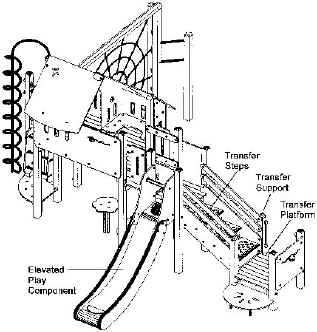
Connected Elevated Components
When transfer systems are used, an elevated play component may connect to other elevated play components, providing an innovative, accessible route.
Consideration should be given to how a play component is utilized when it is selected to connect to other elevated play events. When a transfer system is provided, children move through a play component (such as a crawling tube) using their own strength without a mobility device. Providing variety and excitement through elevated play spaces benefits all children. Tunnels and tubes make "getting there" an activity in itself.
Elevated play components that are connected to other play components count toward fulfilling the requirement for the number of elevated components on an accessible route where transfer systems are used.

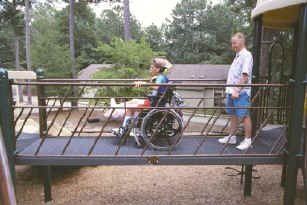
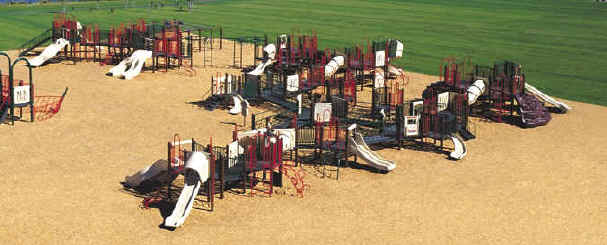
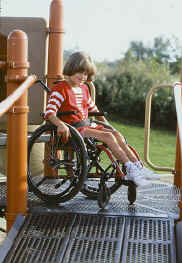
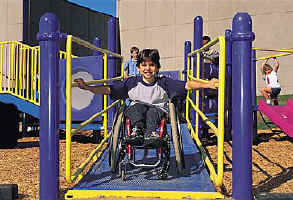
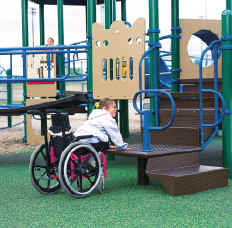
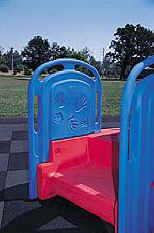
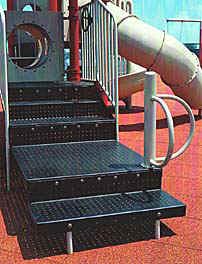
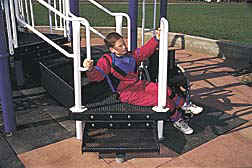
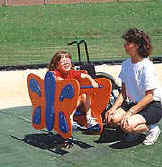
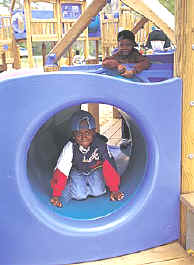
User Comments/Questions
Add Comment/Question